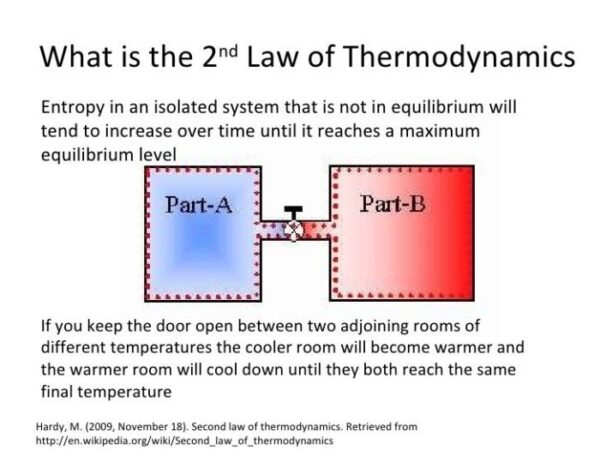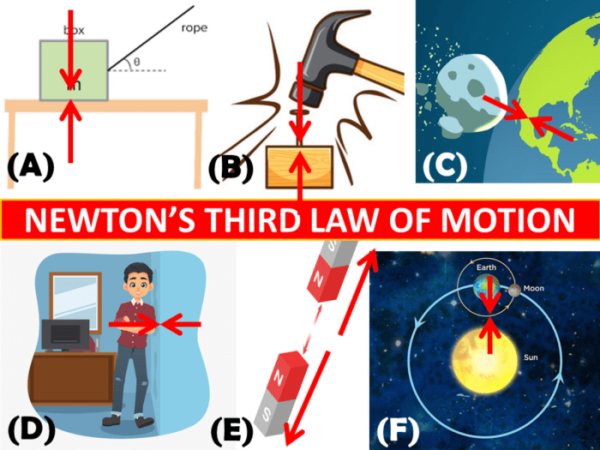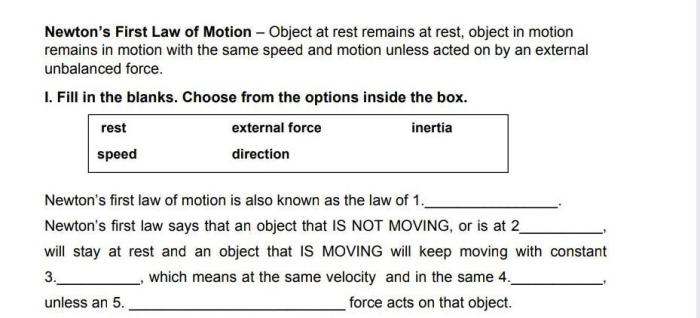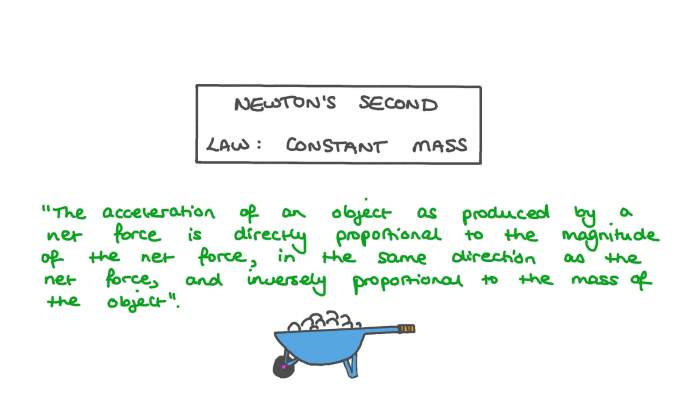
What is newtons first law of motion – What is Newton’s First Law of Motion? This fundamental law of physics, often called the law of inertia, governs the motion of objects in the universe. It explains why objects at rest tend to stay at rest, and objects in motion tend to stay in motion unless acted upon by an external force. This seemingly simple concept has profound implications, influencing everything from the design of vehicles to our understanding of the cosmos.
Newton’s First Law was a revolutionary idea that challenged the prevailing beliefs about motion. Before Newton, it was thought that objects needed a continuous force to maintain their motion. However, Newton’s genius was in recognizing that objects possess an inherent tendency to resist changes in their state of motion. This property is known as inertia, and it is a fundamental property of all matter.
Statement of Newton’s First Law

Newton’s First Law of Motion, also known as the Law of Inertia, is a fundamental principle in physics that describes the behavior of objects in motion or at rest. It forms the foundation for understanding how forces affect objects and their movement.
This law states that an object at rest will remain at rest, and an object in motion will continue in motion with the same speed and in the same direction unless acted upon by an unbalanced force. This means that objects resist changes in their state of motion.
The Importance of Net Force
The concept of “net force” is crucial to understanding Newton’s First Law. Net force refers to the overall force acting on an object, considering the direction and magnitude of all forces involved. If the net force acting on an object is zero, the object will either remain at rest or continue moving at a constant velocity. This is because all the forces are balanced, and there is no unbalanced force to cause a change in motion.
For example, consider a book lying on a table. The book is at rest because the force of gravity pulling it down is balanced by the normal force exerted by the table pushing it up. The net force on the book is zero, so it remains at rest.
Conversely, if an unbalanced force acts on an object, it will cause a change in the object’s motion. For instance, if you push the book on the table, you apply an unbalanced force, causing the book to move.
In essence, Newton’s First Law highlights the inherent tendency of objects to resist changes in their motion. It emphasizes that a force is required to initiate or alter motion and that an object will maintain its state of motion unless acted upon by an external force.
Applications of Newton’s First Law
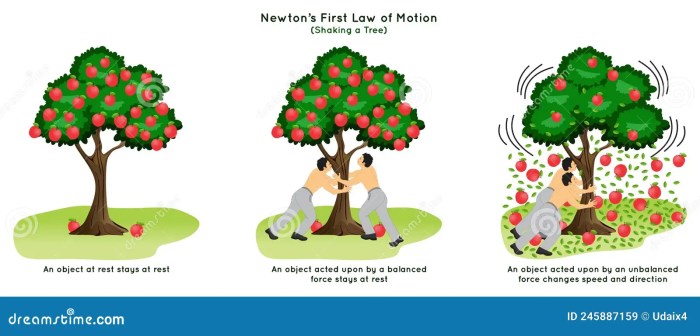
Newton’s First Law of Motion, often referred to as the Law of Inertia, is a fundamental principle in physics that governs the behavior of objects in motion and at rest. It describes the relationship between an object’s inertia and the forces acting upon it. This law has wide-ranging applications in various fields, from everyday experiences to complex engineering designs.
Objects at Rest
Newton’s First Law states that an object at rest will remain at rest unless acted upon by a net external force. This means that an object will not move unless a force is applied to it. For example, a book lying on a table will remain stationary unless someone picks it up or pushes it. The book’s inertia keeps it at rest. Similarly, a car parked on a flat surface will not move unless the engine is started and the car is put in gear.
Objects in Motion
Newton’s First Law also applies to objects in motion. It states that an object in motion will stay in motion at a constant velocity unless acted upon by a net external force. This means that an object moving at a constant speed in a straight line will continue to do so unless a force changes its speed or direction. For instance, a ball rolling across a smooth floor will continue to roll at a constant speed in a straight line until it encounters friction or an obstacle that changes its motion.
Overcoming Inertia
Inertia is the tendency of an object to resist changes in its state of motion. A force is required to overcome an object’s inertia and cause it to accelerate or decelerate. For example, consider a large, heavy box at rest on a flat surface. The box has inertia, meaning it resists being moved. To overcome the box’s inertia and move it, a significant force needs to be applied, such as pushing or pulling it.
Examples of Newton’s First Law in Action: What Is Newtons First Law Of Motion

Newton’s First Law of Motion, also known as the law of inertia, governs the behavior of objects in motion and at rest. This law provides a fundamental understanding of how objects respond to forces or the absence of forces. Let’s explore some real-world examples to illustrate these concepts.
Objects at Rest and in Motion
Understanding Newton’s First Law involves recognizing the behavior of objects in two states: at rest and in motion. The following table highlights the key differences between these states and provides examples.
| State | Description | Example |
|---|---|---|
| At Rest | An object at rest will remain at rest unless acted upon by an unbalanced force. | A book lying on a table will stay put unless someone picks it up or pushes it. |
| In Motion | An object in motion will stay in motion at a constant velocity unless acted upon by an unbalanced force. | A car moving at a constant speed on a straight road will continue moving at that speed unless brakes are applied or a force like friction acts upon it. |
The Role of Friction
Friction is a force that opposes motion between two surfaces in contact. It plays a crucial role in affecting an object’s motion, often acting as the unbalanced force mentioned in Newton’s First Law. Consider the following scenarios:
– Pushing a heavy box across a rough floor: Friction between the box and the floor opposes the motion, making it harder to move the box.
– A car slowing down: Friction between the tires and the road, as well as air resistance, acts as a force opposing the car’s motion, causing it to slow down.
– A ball rolling to a stop: Friction between the ball and the surface it rolls on, along with air resistance, eventually brings the ball to a stop.
Illustrating Inertia with a Simple Experiment
Inertia is the tendency of an object to resist changes in its motion. A simple experiment can demonstrate this concept:
– Materials: A coin and a piece of paper.
– Procedure: Place the coin on top of the paper. Quickly pull the paper out from under the coin.
– Observation: The coin will remain in its initial position, demonstrating inertia. The coin resists the change in motion and tends to stay at rest.
Newton’s First Law and Everyday Life
Newton’s First Law of Motion, often referred to as the law of inertia, governs the behavior of objects in motion or at rest. It’s a fundamental principle that governs our daily lives, from the way we walk to the design of vehicles and safety features.
Everyday Observations
Newton’s First Law is at play in numerous everyday situations. For instance, when a car suddenly stops, our bodies continue to move forward due to inertia. This is why seatbelts are crucial for safety, as they restrain us and prevent us from being thrown forward. Similarly, when a bus takes a sharp turn, passengers lean in the opposite direction due to inertia, as their bodies tend to continue moving in a straight line.
Vehicle Design and Safety
Newton’s First Law plays a significant role in the design of vehicles. The concept of inertia is incorporated into various safety features, such as crumple zones and airbags. Crumple zones are designed to absorb the energy of an impact, slowing down the vehicle gradually and minimizing the force exerted on passengers. Airbags deploy rapidly to cushion the impact and prevent passengers from colliding with the steering wheel or dashboard. These features are crucial for mitigating the effects of inertia in a collision.
Safety Measures and Inertia, What is newtons first law of motion
Safety measures like seatbelts and airbags are designed to counter the effects of inertia. When a vehicle abruptly stops or changes direction, our bodies tend to continue moving in the same direction and at the same speed due to inertia. Seatbelts restrain us, preventing us from being thrown forward, while airbags inflate rapidly to cushion the impact and reduce the force exerted on our bodies. These safety features help to minimize the risk of injury during accidents by mitigating the effects of inertia.
Final Review
Understanding Newton’s First Law is crucial for comprehending the world around us. It explains why we feel a force pushing us back when a car suddenly accelerates, why objects fall to the ground when dropped, and why planets continue to orbit the sun. It also provides the foundation for understanding more complex laws of motion, such as Newton’s Second and Third Laws. By appreciating the power of inertia, we gain a deeper insight into the intricate workings of the universe.
Clarifying Questions
What is the difference between mass and inertia?
Mass is a measure of the amount of matter in an object, while inertia is a measure of an object’s resistance to changes in its motion. The more mass an object has, the greater its inertia.
How does friction relate to Newton’s First Law?
Friction is a force that opposes motion. It acts as an external force that can overcome an object’s inertia and bring it to rest.
Can Newton’s First Law be applied to objects in space?
Yes, Newton’s First Law applies to objects in space as well. In the absence of external forces, objects in space will continue to move in a straight line at a constant speed.

